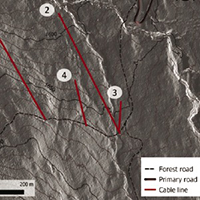Energy efficiency of a hybrid cable yarding system: A case study in the North-Eastern Italian Alps under real working conditions

Published: 30 September 2021
Abstract Views: 1186
PDF: 577
HTML: 5
HTML: 5
Publisher's note
All claims expressed in this article are solely those of the authors and do not necessarily represent those of their affiliated organizations, or those of the publisher, the editors and the reviewers. Any product that may be evaluated in this article or claim that may be made by its manufacturer is not guaranteed or endorsed by the publisher.
All claims expressed in this article are solely those of the authors and do not necessarily represent those of their affiliated organizations, or those of the publisher, the editors and the reviewers. Any product that may be evaluated in this article or claim that may be made by its manufacturer is not guaranteed or endorsed by the publisher.
Similar Articles
- Saddam Hussain, Decong Zheng , Haiyan Song, Muhammad Usman Farid, Abdul Ghafoor, Xinyi Ba, Hao Wang, Wenjun Wang, Alam Sher, Salah Jumaa Alshamali, Computational fluid dynamics simulation and optimisation of the threshing unit of buckwheat thresher for effective cleaning of the cleaning chamber , Journal of Agricultural Engineering: Vol. 53 No. 1 (2022)
- L. Pari, Massimo Brambilla, V. Civitarese, C. Bisaglia, Preliminary evaluation of a short rotation forestry poplar biomass supply chain in Emilia Romagna Region , Journal of Agricultural Engineering: Vol. 44 No. s2 (2013): Proceedings of the 10th Conference of the Italian Society of Agricultural Engineering
- Ugo Lazzaro, Caterina Mazzitelli, Benedetto Sica, Paola Di Fiore, Nunzio Romano, Paolo Nasta, On evaluating the hypothesis of shape similarity between soil particle-size distribution and water retention function , Journal of Agricultural Engineering: Vol. 54 No. 4 (2023)
- Alberto Barbaresi, Daniele Torreggiani, Francesco Tinti, Patrizia Tassinari, Analysis of the thermal loads required by a small-medium sized winery in the Mediterranean area , Journal of Agricultural Engineering: Vol. 48 No. s1 (2017): Special Issue
- Vincenzo Bagarello, Vito Ferro, Dennis Flanagan, Predicting plot soil loss by empirical and process-oriented approaches. A review , Journal of Agricultural Engineering: Vol. 49 No. 1 (2018)
- Andrea Casson, Valentina Giovenzana, Alessio Tugnolo, Alessia Pampuri, Ilaria Fiorindo, Roberto Beghi, Riccardo Guidetti, Assessment of an expanded-polypropylene isothermal box to improve logistic sustainability of catering services , Journal of Agricultural Engineering: Vol. 52 No. 2 (2021)
- Lorenzo Vergni, Alessandra Vinci, Francesca Todisco, Francesco Saverio Santaga, Marco Vizzari, Comparing Sentinel-1, Sentinel-2, and Landsat-8 data in the early recognition of irrigated areas in central Italy , Journal of Agricultural Engineering: Vol. 52 No. 4 (2021)
- Bing Li, Jiyun Li, Key technology of crop precision sowing based on the vision principle , Journal of Agricultural Engineering: Vol. 54 No. 1 (2023)
- Ildar Badretdinov, Salavat Mudarisov, Eduard Khasanov, Ruslan Nasyrov, Marat Tuktarov, Operation technological process research in the cleaning system of the grain combine , Journal of Agricultural Engineering: Vol. 52 No. 2 (2021)
- Yanmei Meng, Tingting Zhang, Jin Wei, Jinlai Zhang, Xulei Zhai, Design and experiments of an automatic pipe winding machine , Journal of Agricultural Engineering: Vol. 54 No. 2 (2023)
<< < 2 3 4 5 6 7 8 9 10 11 > >>
You may also start an advanced similarity search for this article.

 https://doi.org/10.4081/jae.2021.1185
https://doi.org/10.4081/jae.2021.1185







